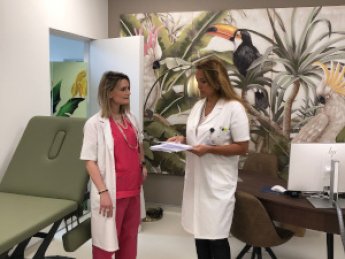Breast Fibroadenoma
What is a breast fibroadenoma? Symptoms, diagnosis and treatment
Breast fibroadenomas are the most common type of breast tumor. They affect up to 20% of women and can develop at any age, though they are most frequent between the ages of 15 and 35. These benign tumors are made up of a mass of fibroglandular breast tissue.
A single fibroadenoma or multiple fibroadenomas may develop in one or both breasts. The occurrence of breast fibroadenomas fluctuates, meaning they can disappear and come back later.
Breast fibroadenomas must be accurately diagnosed through imaging (ultrasound followed by mammogram and biopsy if necessary) to formally rule out the possibility of a cancerous tumor. How they are treated depends on their size and growth rate, and on whether or not there are associated symptoms.
What are the symptoms of a breast fibroadenoma?
Fibroadenomas are usually painless and asymptomatic. In some cases, they may make the breasts feel tender or cause pain on palpation.
They generally grow slowly and are detected either by self-examination or during a manual breast examination by a medical professional. Typically, they develop as a small lump with a firm, rubbery consistency. Fibroadenomas can also cause physical, aesthetic or mental discomfort.
Fibroadenoma size may vary based on the menstrual cycle. They do not cause discharge from the nipple, tightening of the skin, alteration of skin color or lymph nodes in the armpit. If any of these symptoms occur, the patient must undergo testing to rule out the possibility of cancer.
Rapid Diagnosis
What are the main risk factors for developing breast fibroadenomas?
The precise causes of fibroadenomas are unknown. Hormonal factors relating to the menstrual cycle are often evoked, since fibroadenomas develop more frequently in women of child-bearing age and tend to regress after menopause.
How are fibroadenomas diagnosed at the American Hospital of Paris?
Fibroadenomas that are more than 2 centimeters in diameter can usually be felt easily by the patient or the practitioner performing the palpation. However, it is impossible to distinguish between a fibroadenoma and other types of breast tumors using the manual method only. Imaging tests are needed to diagnose a fibroadenoma.
- Breast ultrasound: Ultrasound is the leading type of imaging exam, and can be used to identify a nodule that is even and smooth, with clear-cut borders.
- Mammogram: A mammogram is not the most efficient exam for fibroadenoma diagnosis, especially in young patients. However, some fibroadenomas are discovered by chance during a screening mammogram.
- Breast biopsy: A biopsy is only performed when the ultrasound exam raises a doubt. It consists in removing a small sample of tissue from the tumor using a needle. The sample is then sent to a lab for histological analysis to confirm the diagnosis.
Are fibroadenomas a risk factor for breast cancer?
Based on current knowledge, fibroadenomas are not a risk factor for breast cancer. However, phyllode tumors, which cause a rare type of breast cancer, may appear similar to an adenoma during the clinical exam and on imaging results. The signs that might indicate the presence of a phyllode tumor rather than a fibroadenoma include:
- Patient is slightly older (around 45 years old) than the typical age for fibroadenomas
- Diameter of more than three centimeters
- Rapidly growing tumor
- Atypical imaging results
Phyllode tumors must be detected early to ensure rapid treatment. This is why a biopsy is often performed.
What treatments for breast fibroadenomas are available at the American Hospital of Paris?
Surveillance
Surveillance through self-examination and medical examination of the breasts is most frequently prescribed. Additional tests including imaging and biopsy can also be prescribed if there is the slightest doubt.
Other treatment options can be discussed if the fibroadenoma is large (more than two or three centimeters in diameter), when it causes physical or aesthetic discomfort, or if the tumor is growing quickly. Its psychological impact can also be taken into consideration, as some patients feel very anxious about the presence of the fibroadenoma and request treatment to have it removed.
Surgical Treatment
Surgical treatment generally consists in the removal of the fibroadenoma. The procedure is usually performed under general anesthesia on an outpatient basis (the patient is admitted in the morning and discharged at the end of the day). The surgery does not alter the shape of the breast, and the scar is as discreet as possible.
Cryoablation, an alternative to surgery for the treatment of fibroadenomas
Cryotherapy is a technique used to destroy the fibroadenoma using extreme cold. Guided by ultrasound, the surgeon inserts a needle into the fibroadenoma. The temperature of the needle is then lowered to -180° C (-292° F), creating an ice ball around the tumor. The freezing process lasts around ten minutes, after which the needle is removed.
The advantage of this method is its minimally invasive nature: performed under local anesthesia, it requires just a few hours of recovery in the outpatient department. In addition, cosmetic outcomes are excellent, as the breast structure is left intact. There is virtually no loss of breast volume, and the scar is just a few millimeters long.
The post-operative period is often very simple, with no need for bandages or at-home care provided by a nurse.
Learn more about breast cryoablation
Learn more

